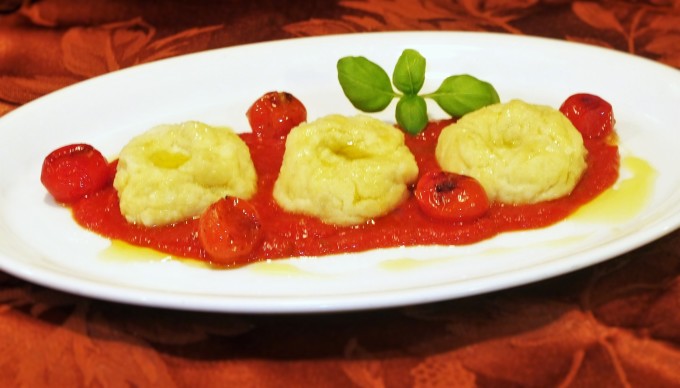Gnudi di Ricotta are, in fact, naked ravioli. No joke! Try to imagine your favorite ricotta ravioli filling minus the pasta. If you carefully work the filling into small quenelles or round shapes, you have a gnudi. Or, as the translation goes – naked ravioli. Now that’s Italian!
These cheese dumplings cook up quickly and are light and fluffy as a cloud. They are a delicious treat!
The trick to making them so delectable is to not overwork the mixture and not to add too much flour to bind them. And, by all means DO NOT ADD BREAD CRUMBS to the mix. Gnudi are supposed to be moist and sticky.
Yes, this can make them difficult to work with, but by mastering the simple techniques I share with you in this recipe you’ll be able to overcome the obstacles this type of dough presents and get a traditional, delicious result that will be slightly textured on the outside and pillow soft on the inside.
Take your time with this recipe especially when shaping the gnudi. Your end result will have no place to hide.
Gnudi di Ricotta
(Serves 4-6)
Ingredients:
- 1-3/4 cups ( 400g) – Ricotta
- 1-1/4 cups ( 150g) – Parmesan or Grana Padano ( finely grated)
- 3 – Eggs
- 3/4 cup ( 120g) – All Purpose Flour
- 1/2 teaspoon – Salt
- 1/2 teaspoon – White Pepper
- 1/4 teaspoon – Nutmeg
- 3 cups – Semolina
Procedure:
- Drain any excess liquid from the ricotta.
- In a mixing bowl, combine the ricotta, grated cheese, eggs, salt, white pepper and nutmeg.
- Whisk vigorously to incorporate all ingredients evenly and to aerate the mixture. (This will help to ensure a light fluffy interior.)
- Next, add the flour in three stages. When one addition is just incorporated, add the next. Over mixing will create an unwanted gummy texture. So, be careful to not over mix.
- At this stage cover the bowl with plastic wrap and place in the refrigerator for 20-30 minutes. This will allow the flour to be absorbed and chill the mixture so it’s easier to shape.
- Line a baking tray or large dish with a nice dusting of semolina. Place the rest of the semolina on a large enough tray to roll and coat the gnudi.
- Remove the bowl from the refrigerator and immediately begin to shape the gnudi. Lightly dust your hands with flour and roll into one-inch size balls. Continue to flour your hands as necessary. If your hands too get sticky, wash them off, dry well and then dust your palms again with flour and proceed.
- Another method is to use two medium spoons to create quenelle shapes.
The manner in which you shape the gnudi is entirely up to you. Both methods make a great end result
- As you shape the dumplings, place them on the working tray with the semolina and carefully roll them well to coat all around.
- I like to dimple the top to hold the Extra Virgin Olive Oil or sauce.
- Then place them on your holding tray that’s dusted with semolina.
- Leave the gnudi out once for about an hour after you’ve completed the shaping and coating process to dry slightly.
- This will help the dumplings form a textured outer shell that will help encase the soft delectable cheese center.
- Then wrap them lightly with plastic wrap and place in the refrigerator until ready to use.
To Cook:
- Bring a large pot of water to the boil. Then salt the water and gently add the gnudi.
- Stir carefully to ensure that they do not stick together and bring back to a boil.
- Once boiling, reduce the heat so the water is at a strong simmer. (No rapid boil at this point!)
- The gnudi should begin to float to the top in about 3-5 minutes time.
- Once they float they are done. Remove quickly with a slotted spoon and serve.
Sauce:
- Gnudi are typically served in a quick brown butter and sage sauce. Personally I like them with a simple tomato sauce, roasted grape tomatoes and a liberal drizzle of extra virgin olive oil.
Since these are “naked ravioli” I do not cover them in the sauce. I prefer to lay them on top of the sauce and let their bare beauty shine!


